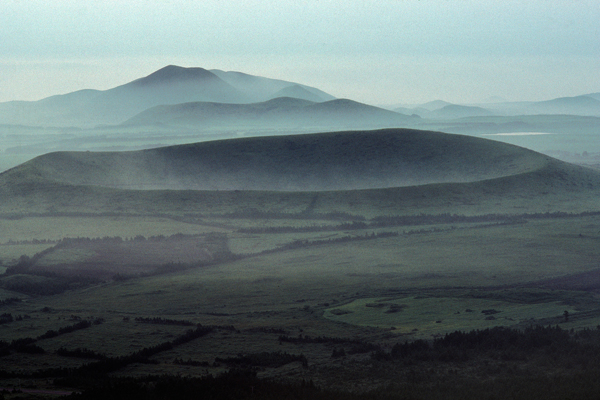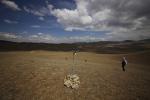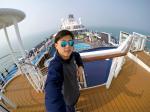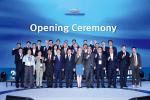| |
 |
|
| ¡ã Mt. Halla looms on the horizon. Photo courtesy Jeju Special Self-Governing Province |
Jeju is the only place on the planet to hold three UNESCO environmental mandates: World Natural Heritage, Biosphere Reserve and Global Geopark. The island of the “three plenties” is rightly proud of this modern-day troika.
Geopark status was granted in 2010, on Oct. 4 in Lesvos, Greece, by the Global Geoparks Network. Jeju became GGN’s 20th member and nine sites across Jeju Island received Geopark certification.
While GGN is affiliated with UNESCO, it is independent in structure and receives logistical support in a partnership relationship. GGN states on its website:
“Under the umbrella of UNESCO, and through cooperation with the global network partners, important local and national geological sites gain worldwide recognition and benefit from the exchange of knowledge and expertise with staff of other Geoparks.”
“UNESCO and the GGN develop models of best practice and set quality standards for territories that integrate the preservation of geological heritage into strategies for regional sustainable economic development.”
Jeju applied for Geopark status in 2009 and after an international inspection team visited in the summer of 2010, the nine sites were assessed and designated. These are:
Mt. Halla, Seongsan Sunrise Peak, Manjang Cave, Seogwipo Formation, Mt. Sanbang, Dragon Head Rock Cliff, Suwol Peak, Cheonjiyeon Waterfalls and Daepo Columnar Joint.
Please enjoy our traveler’s guide to each site and visit our website for more detailed coverage.
| |
 |
|
| The cliff at Suwol Peak. ¡ã Photo courtesy Jeju Special Self-Governing Province |
Suwol Peak (¼ö¿ùºÀ)
77-meters high and formed 18,000 years ago, Suwol Peak is part of a tuff ring that was formed by subterranean magma reacting with subterranean water, and exploding and accumulating volcanic material. A very well known site for volcanology both locally and internationally.
Location: Jeju, Hangyeong-myeon
Transport: Jeju Intercity Bus Terminal⇨Pyeonghwar-o bus⇨Shinpyeong-ri⇨Change at Shinpyeong-ri to: Eupmyeon Circular bus⇨Hanjangdong (2 hrs)
Seogwipo Intercity Bus Terminal⇨Seoilju bus⇨Inseong-ri⇨Change at Inseongri to: Eupmyeon Circular bus⇨Hanjang-dong (1 hr 30 mins)
Visiting: no restriction
Entrance fee: free
Dragon’s Head Coast (¿ë¸Ó¸®ÇؾÈ)
Running to the coastline from Mt. Sanbang, this is a tuff ring caused by volcanic activity which is visible in the layered ash and marble pattern along the coast. This is a popular tourist attraction for its scenic views.
Location: Sagye-ri, Andeok-myeon, Seogwipo City
Transport: Jeju Intercity Bus Terminal⇨Jungmungosok bus⇨Changcheon Elementary School⇨Seoilju bus⇨Sanbangsan (1 hr 30 mins)
Seogwipo Intercity Bus Terminal⇨Seoilju bus⇨Sanbangsan (40 mins)
Visiting: May-Sept. 8 a.m.~6 p.m., Oct.-Apr. 8:30 p.m.~ 5:30 p.m.
Entrance fee: 2,000 won
| |
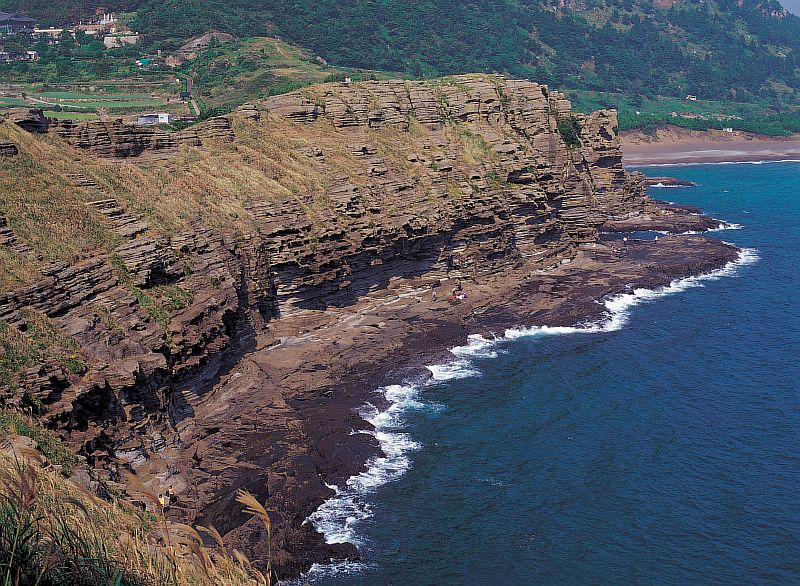 |
|
| ¡ã Dragon's Head Coast in Seogwipo City. Photo courtesy Jeju Special Self-Governing Province |
Mt. Sanbang (»ê¹æ»ê)
395 meters tall and formed 800,000 years ago. this bell-shaped lava dome was formed by lava accumulating at a volcanic crater due to high viscosity. Its cave has been designated one of Jeju’s 10 sights for its spectacular views of Dragon’s Head Coast, Hyeongje Island, and Gapa Island.
Location: Andeok-myeon, Seogwipo City
Transport: Jeju Intercity Bus Terminal⇨Jungmungosok bus⇨Changcheon Elementary School⇨Seoilju bus⇨ Mt. Sanbang (1 hr 30 mins)
Seogwipo Intercity Bus Terminal⇨Seoilju bus⇨ Mt. Sanbang (40 mins)
Visiting: May-Sept. 8:30 a.m. ~ 6:30 p.m.
Oct-Apr 8:30 a.m. ~ 6 p.m.
Entrance fee: 1,000 won
Daepo Columnar Joint (´ëÆ÷ÁÖ»óÀý¸®)
This feature is 2-kilometers long from Daepo-dong to Jungmun-dong in Seogwipo City and was formed between 250,000 to 140,000 years ago, when the adjacent Oreum “Nokhajiak” erupted and solidified at the coast. The rocks are hexagonally shaped and similar to a beehive in structure.
Location: Jungmundong, Seogwipo City
Transport: Jeju Intercity Bus Terminal⇨Jungmungosok bus⇨Jungmun-dong⇨# 5 bus⇨ICC (2 hrs)
Seogwipo Intercity Bus Terminal⇨# 110 bus⇨ICC (43 mins)
Visiting: 9 a.m. ~ 6 p.m.
Entrance fee: 2,000 won
| |
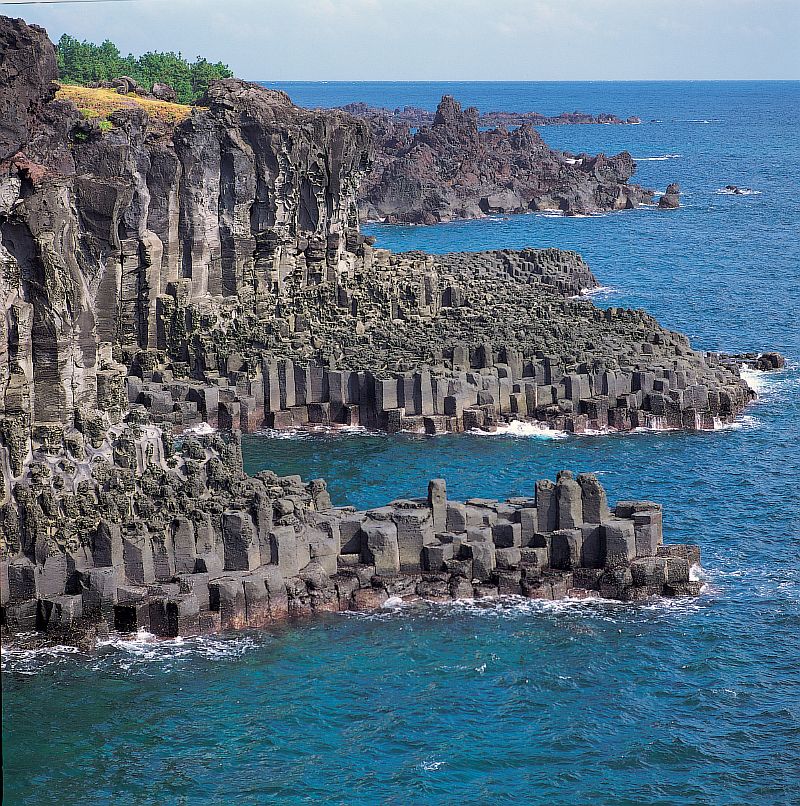 |
|
| ¡ã Daepo Columnar Joint in Seogwipo City. Photo courtesy Jeju Special Self-Governing Province |
Mt. Halla (ÇѶó»ê)
1,950 meters high and the tallest mountain in Korea, Mt. Halla has Baekrokdam at its top, a 108-meter-deep and 550-meter-wide crater lake. Providing an ecosystem for various species of plants and animals, it is a UNESCO World Natural Heritage site.
Eorimok
Location: Haean-dong, Jeju City
Transport: Jeju Intercity Bus Terminal⇨1100 bus⇨Eorimok (50 mins)
Seogwipo Intercity Bus Terminal⇨Jungmungosok⇨ 1100 road entrance⇨1100 bus⇨Eorimok
(1 hr 30 mins)
Visiting: Nov. ~ Feb. last entry 12 pm; March~ Oct. last entry 2 p.m.
Entrance fee: free
Yeongshil
Location: Hawon-dong, Seogwipo City
Transport: Jeju Intercity Bus Terminal⇨1100 bus⇨Yeongshil ticket office (1 hr)
Seogwipo Intercity Terminal⇨Jungmungosok⇨1100 road entrance⇨1100 bus⇨Yeongshil ticket office (1 hr)
Visiting: 5 a.m.~3 p.m. (must enter by 2:30 p.m.)
Entrance fee: free
Seongpanak
Location: Gyorae-ri, Jocheoneup, Jeju City
Transport: Jeju Intercity Bus Terminal⇨5.16 bus⇨Seongpanak (50 mins)
Seogwipo Intercity Bus Terminal⇨5.16 bus⇨Seongpanak (1 hr 10 mins)
Visiting: 5 a.m. ~12 p.m.
Entrance fee: free
Gwaneumsa
Location: Odeungdong, Jeju City
Transport: Jeju Intercity Bus Terminal⇨5.16 bus⇨Jeju National University⇨#1 bus⇨Gwaneumsa (35 mins)
Seogwipo Intercity Bus Terminal⇨5.16 bus⇨Sancheondan⇨#1 bus⇨Gwaneumsa (1 hr 50 mins)
Visiting: 5:30 a.m. - 9 p.m.
Entrance fee: free
Seogwipo Formation (¼±ÍÆ÷Ãþ)
The 40-meter thick exposed formation is composed of mainly basaltic volcaniclastic rock and lesser amounts of non-volcanic sedimentary layers deposited in the early to middle Pleistocene. Because of the fossil diversity contained in the formation, it was designated a natural monument.
Location: Seogwipo, Seohong-dong
Transport: Jeju Intercity Bus Terminal⇨5.16 bus⇨Segi APT⇨# 8 bus⇨Namseong Village (2 hrs)
Seogwipo Intercity Bus Terminal⇨#100 bus⇨Seomun Rotary (32 mins)
Visiting: 8 am ~ 9:10 p.m.
Entrance fee: 2,000 won
| |
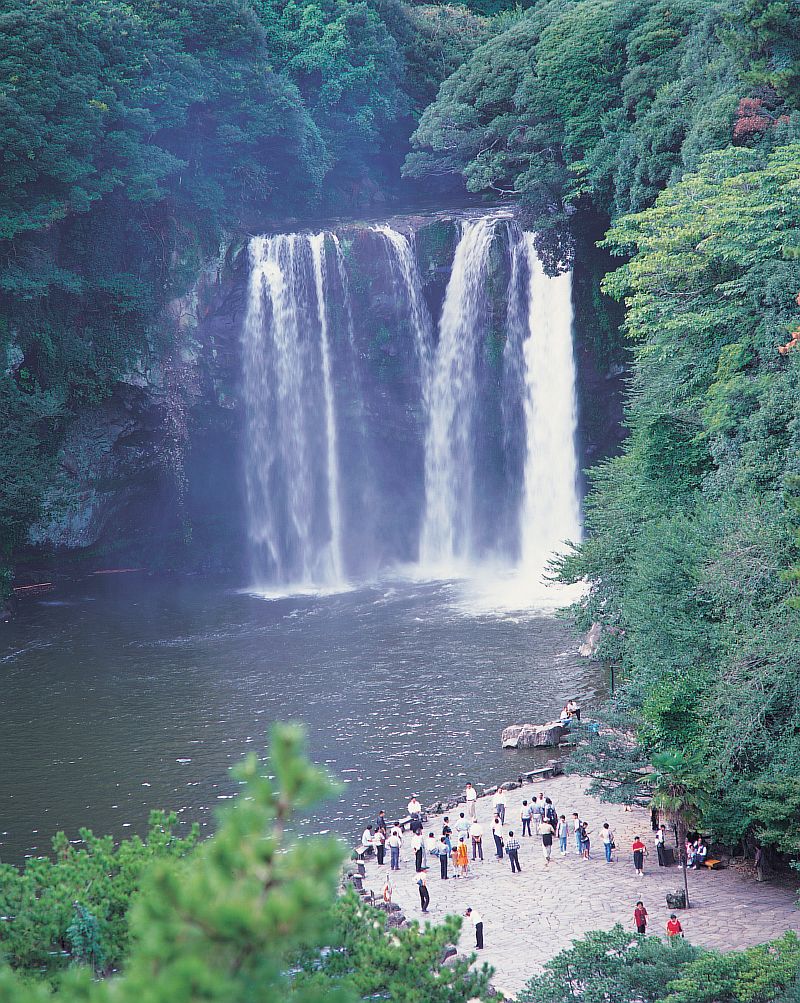 |
|
| ¡ã Cheonjiyeon Falls, Seogwipo City. Photo courtesy Jeju Special Self-Governing Province |
Cheonjiyeon Falls (õÁö¿¬ÆøÆ÷)
22-meters tall and 12-meters wide, this waterfall has carved a 20-meter-deep base. Home to the Mootae eel, Korean Natural Monument No. 258, and also the Dampalsu tree, Natural Monument No. 163, the area is habitat for a prototypical Korean evergreen forest.
Location: Seogwi-dong, Seogwipo City
Transport: Jeju Intercity Bus Terminal⇨5.16 bus⇨Dongmun Rotary (1hr 20 min)
Seogwipo Intercity Bus Terminal⇨Dongilju bus⇨Dongmun Rotary (20 min)
Visiting: Sunrise ~10:20 p.m.
Entrance fee: 2,000 won
Seongsan Sunrise Peak (¼º»êÀÏÃâºÀ)
This 1.5-kilometers long, 100-meter-thick sedimentary layer formed between 1.8 million and 400,000 years ago through volcanic activity layering it with volcanic ejecta and marine sediments.
Location: Seongsan-ri, Seongsan-eup, Seogwipo City ¼±ÍÆ÷½Ã¼º»êÀ¾¼º»ê¸®
Transport: Jeju Intercity Bus Terminal⇨Dongilju bus⇨Seongsan-ri (2 hrs)
Seogwipo Intercity Bus Terminal⇨Dongilju bus⇨Seongsan-ri (2 hrs 20 mins)
Visiting: 4:30 a.m.~7:30 p.m.
Entrance fee: 2,000 won
| |
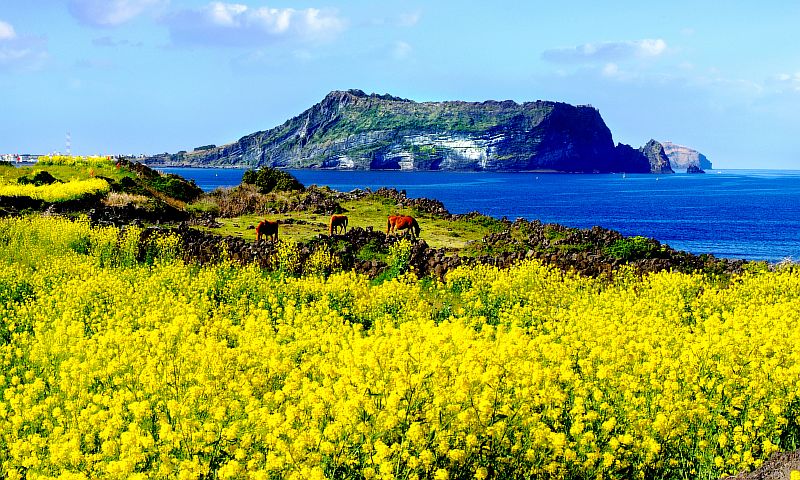 |
|
| ¡ã Seongsan Sunrise Peak, Seogwipo City. Photo courtesy Jeju Special Self-Governing Province |
Manjang Cave (¸¸Àå±¼)
Beginning at Geomun Oreum, a World Natural Heritage site, this cave is 7,400 meters long, 40 meters high and 23 meters wide. A section of the cave has a multi-layer structure which divides itself into a upper-layer and a lower-layer cave. There are three main entrances of which only two are open to the public and extend about 1 kilometer underground.
Location: Jeju, Gujwaeup, Gimneyong-ri Á¦Áֽñ¸ÁÂÀ¾±è³ç¸®
Transport: Jeju Intercity Bus Terminal⇨Dongilju bus⇨Manjang Cave⇨Walk 20~30 mins (about 2 km)⇨Cave entrance (1 hr 30 mins)
Seogwipo Intercity Bus Terminal⇨Jungmungosok bus⇨Jeju Intercity Bus Terminal⇨Eupmyeon Circular bus⇨Manjang cave (2 hrs 30 mins)
Visiting: 9 a.m.~ 5 p.m. (cave viewing until 6 p.m.)
Entrance fee: 2,000 won
|

















